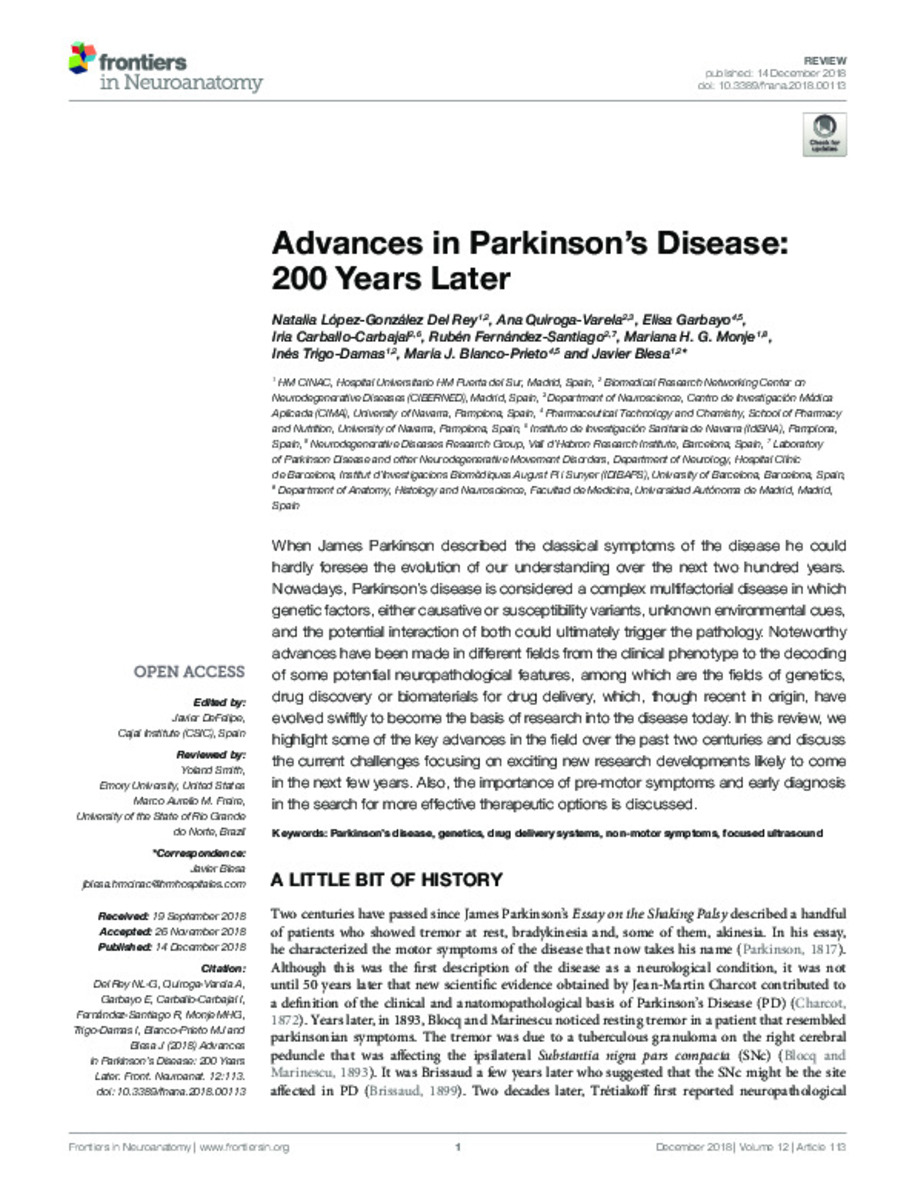Full metadata record
| DC Field | Value | Language |
|---|---|---|
| dc.creator | López-González, N. (Natalia) | - |
| dc.creator | Quiroga-Varela, A. (Ana) | - |
| dc.creator | Garbayo, E. (Elisa) | - |
| dc.creator | Carballo-Carbajal, I. (Iria) | - |
| dc.creator | Fernández-Santiago, R. (Ruben) | - |
| dc.creator | Monje, M.H.G. (Mariana H. G.) | - |
| dc.creator | Trigo-Damas, I. (Inés) | - |
| dc.creator | Blanco-Prieto, M.J. (María José) | - |
| dc.creator | Blesa, J. (Javier) | - |
| dc.date.accessioned | 2023-02-09T09:00:50Z | - |
| dc.date.available | 2023-02-09T09:00:50Z | - |
| dc.date.issued | 2018 | - |
| dc.identifier.citation | López-González, N. (Natalia); Quiroga-Varela, A. (Ana); Garbayo, E. (Elisa); et al. "Advances in parkinson's disease: 200 years later". Frontiers in neuroanatomy. 12 (113), 2018, | es_ES |
| dc.identifier.issn | 1662-5129 | - |
| dc.identifier.uri | https://hdl.handle.net/10171/65386 | - |
| dc.description.abstract | When James Parkinson described the classical symptoms of the disease he could hardly foresee the evolution of our understanding over the next two hundred years. Nowadays, Parkinson's disease is considered a complex multifactorial disease in which genetic factors, either causative or susceptibility variants, unknown environmental cues, and the potential interaction of both could ultimately trigger the pathology. Noteworthy advances have been made in different fields from the clinical phenotype to the decoding of some potential neuropathological features, among which are the fields of genetics, drug discovery or biomaterials for drug delivery, which, though recent in origin, have evolved swiftly to become the basis of research into the disease today. In this review, we highlight some of the key advances in the field over the past two centuries and discuss the current challenges focusing on exciting new research developments likely to come in the next few years. Also, the importance of pre-motor symptoms and early diagnosis in the search for more effective therapeutic options is discussed. | es_ES |
| dc.description.sponsorship | The authors NDR, IT-D, and JB are currently funded by grant S2017/BMD-3700 (NEUROMETAB-CM) from Comunidad de Madrid co-financed with the Structural Funds of the European Union, Fundación BBVA and Fundación Tatiana Pérez de Guzmán el Bueno; RF-S was supported by a Jóvenes Investigadores grant (#SAF2015-73508-JIN) through the Programa Estatal de Investigación, Desarrollo e Innovación Orientada a los Retos de la Sociedad (Plan Estatal de I+D+I 2013–2016) of the Spanish Ministry of Economy and Competitiveness (MINECO), and the Agencia Estatal de Investigación (AEI), which is cofunded by FEDER (AEI/FEDER/UE). | es_ES |
| dc.language.iso | eng | es_ES |
| dc.publisher | Frontiers | es_ES |
| dc.rights | info:eu-repo/semantics/openAccess | es_ES |
| dc.subject | Parkinson’s disease | es_ES |
| dc.subject | Genetics | es_ES |
| dc.subject | Drug delivery systems | es_ES |
| dc.subject | Non-motor symptoms | es_ES |
| dc.subject | Focused ultrasound | es_ES |
| dc.title | Advances in parkinson's disease: 200 years later | es_ES |
| dc.type | info:eu-repo/semantics/article | es_ES |
| dc.description.note | This is an open-access article distributed under the terms of the Creative Commons Attribution License (CC BY). The use, distribution or reproduction in other forums is permitted, provided the original author(s) and the copyright owner(s) are credited and that the original publication in this journal is cited, in accordance with accepted academic practice. No use, distribution or reproduction is permitted which does not comply with these terms. | es_ES |
| dc.identifier.doi | 10.3389/fnana.2018.00113 | - |
| dadun.citation.number | 113 | es_ES |
| dadun.citation.publicationName | Frontiers in neuroanatomy | es_ES |
| dadun.citation.volume | 12 | es_ES |
| dc.identifier.pmid | 30618654 | - |
Files in This Item:
Statistics and impact
Items in Dadun are protected by copyright, with all rights reserved, unless otherwise indicated.






